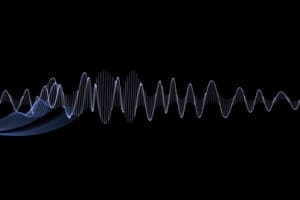Podcast
Questions and Answers
What is the direction of transmitter motion that causes an apparent increase in the transmitted frequency?
What is the direction of transmitter motion that causes an apparent increase in the transmitted frequency?
- Away from the receiver and towards the transmitter
- In a circular motion around the receiver
- Towards the receiver and away from the transmitter (correct)
- Perpendicular to the receiver
What is the principle behind the Doppler Navigation System?
What is the principle behind the Doppler Navigation System?
- Measuring the phase shift of transmitted radio signals
- Comparing the frequency of transmitted and received radio signals (correct)
- Measuring the time delay between transmitted and received radio signals
- Determining the velocity of the transmitter using trigonometry
When does an apparent decrease in the transmitted frequency occur due to the Doppler effect?
When does an apparent decrease in the transmitted frequency occur due to the Doppler effect?
- When the transmitter and receiver are moving in the same direction
- When the transmitter moves away from the receiver (correct)
- When the transmitter moves in a circular motion around the receiver
- When the transmitter and receiver are stationary
What is the result of the transmitter moving towards the receiver on the transmitted frequency?
What is the result of the transmitter moving towards the receiver on the transmitted frequency?
What is the relationship between the transmitter velocity and the apparent change in frequency?
What is the relationship between the transmitter velocity and the apparent change in frequency?
Flashcards are hidden until you start studying
Study Notes
Doppler Effect
- An apparent increase in the transmitted frequency occurs when the transmitter moves towards the receiver or the receiver moves towards the transmitter.
- An apparent decrease in the transmitted frequency occurs when the transmitter moves away from the receiver.
Doppler Navigation System
- The Doppler Navigation System is based on the Doppler effect.
Doppler Effect Scenarios
- When the transmitter moves away from the receiver, an apparent decrease in the transmitted frequency occurs, proportional to the transmitter's velocity.
- When the transmitter moves towards the receiver, an apparent increase in the transmitted frequency occurs, proportional to the transmitter's velocity.
- When both the transmitter and receiver move towards each other, an apparent increase in the transmitted frequency occurs, proportional to the transmitter's velocity.
Studying That Suits You
Use AI to generate personalized quizzes and flashcards to suit your learning preferences.




